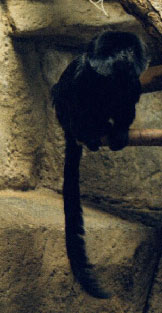This species could be considered an intermediate form between the tamarins and marmosets and the cebids. The Goeldi’s marmoset has claws instead of nails, except for the hallux, which has a nail (Heltne et al., 1981), like the marmosets, and three molar teeth, which is like the cebids. Also like the cebids the molars are quadritubercular (Heltne et al., 1981). This species has a dental formula of 2:1:3:3 on both the upper and lower jaws (Heltne et al., 1981). The scapula is unique in shape having the superior scapular border and the spinous process parallel in length, and this may assist in quadrupedal locomotion (Davis, 1994). The pelage color for this species is black, and the pelage ranges from 1 to 2 centimeters long over the body (Heltne et al., 1981). The skin of lips, snout, rims of ears, and the dorsal and volar surfaces of the hands and feet are colored black, with the skin of face being slightly lighter in color (Heltne et al., 1981). The remaining skin is colored bone-white or pink, but is usually covered by thick pelage (Heltne et al., 1981). Around the ears and going down the cheeks to the lips are hairs longer than found on the face (Heltne et al., 1981). The infant pelage may vary from the adult's in that the saddle hairs may have a whitish or golden terminal band (Heltne et al., 1981). Also on the ventral surface of the infant there is a glandular area over the manubrium containing hairs that are slightly longer than the other hairs found on the ventral surface (Heltne et al., 1981). The mean body mass for adult males was found to be 366 grams and for females it is 355 grams (Encarnacion and Heymann, 1998).
RANGE:
The Goeldi’s marmoset is found in the upper Amazonian rainforests of Southern Colombia, Eastern Ecuador, Eastern Peru, Western Brazil, and Northern Bolivia (Nowak, 1999). This species is found from the south bank of the Caqueta River in Colombia, through the Amazonian region of Peru and Ecuador to the north of the Madre de Dios River in western Pando Bolivia (Heltne et al., 1981). This species has also been found to occur in South-western Brazilian Amazonia in the state of Rondonia, north of the Abuna River (Ferrari et al., 1999). This species prefers bamboo, mixed secondary, and scrub forests (Heltne et al., 1981). In the Andean foothills, this species occurs at a level up to 500 meters (Heltne et al., 1981). In Bolivia this species was always found in primary riverine forests, usually at heights ranging from 0 to 9 meters (Christen and Geissmann, 1994; Christen, 1999). In the dense lower levels of bamboo forests, this species prefers to live 1 to 3 meters above the ground (Davis, 1994).



